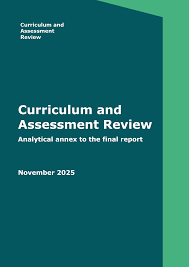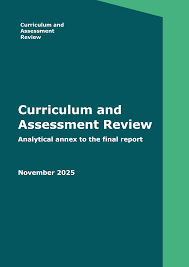Reading the Curriculum Review as a Geography Teacher (Part 2)
Fieldwork, enquiry and the geography curriculum
In the first post of this series, I explored how the Curriculum and Assessment Review renews the call for a coherent, knowledge-rich curriculum that develops powerful understanding over time. This second piece looks at an area where geography should already feel confident: fieldwork.
When I led the writing of Ofsted’s subject report Getting Our Bearings (2023), one of its clearest findings was that the quality of fieldwork varied significantly across schools. Too often, it had been squeezed to the margins, treated as a one-off trip rather than a central strand of the curriculum. The report argued that pupils should learn about fieldwork as well as through fieldwork — building the knowledge, skills and understanding that enable them to investigate the world systematically.
The new Curriculum and Assessment Review reaches a strikingly similar conclusion. It describes enrichment, outdoor learning and real-world investigation as essential to a “world-class curriculum for all.” For geography, this alignment is a call to action.
What the two reports agree on
Both Getting Our Bearings and the CAR make the same fundamental point: fieldwork is curriculum. It is not an enrichment activity bolted on to “real” geography teaching. It is one of the main ways pupils learn to think geographically.
The Ofsted report showed that in the strongest curricula, fieldwork was carefully sequenced. Pupils first learned the disciplinary knowledge needed to plan an investigation — framing questions, understanding sampling, recognising bias — before collecting data in the field.
The CAR echoes this, urging schools to integrate practical and investigative learning throughout subjects, ensuring all pupils gain experience of applying knowledge, not just memorising it.
Both highlight inclusion. Every young person, regardless of background or need, should have access to the sense of curiosity and capability that fieldwork brings.
In other words, both reports argue that geography’s practical dimension is not a luxury; it is how the subject comes to life.
Fieldwork as enquiry, not excursion
It is worth restating what “fieldwork” actually means.
It is easy to imagine pupils on a windy beach with clipboards, but fieldwork begins long before the coach leaves the car park and continues long after they return.
A true fieldwork curriculum teaches pupils how geographical enquiry works:
Framing questions: What do we want to find out? How can geographical concepts guide our investigation?
Collecting data: How do we design a sample, choose equipment, record accurately, and work safely?
Presenting data: How do we select graphs, maps or visualisations that reveal patterns clearly?
Analysing and interpreting: What does the evidence show? How do we explain anomalies or uncertainty?
Evaluating: How might we improve our methods or question our assumptions?
These stages are as much a part of fieldwork as the time spent outdoors. When pupils learn them deliberately, they are learning the disciplinary craft of geography.
This is where the CAR’s vision of “life skills” and “practical understanding of the world” intersects precisely with the pedagogy of geographical enquiry that I explore in Powerful Geography 2.
Why this matters for curriculum design
Both reports agree that fieldwork should progress through the key stages. Pupils in Year 7 might begin by describing and classifying local land use. By Year 9 they should be designing investigations, using GIS, and evaluating their own data. At GCSE and beyond, they should be planning and executing independent enquiries.
This requires curriculum time and deliberate teaching. The Review’s suggestion that schools reduce exam volume should help here. Freeing even a small amount of time from assessment rehearsals could give geography departments space to teach the full cycle of enquiry properly.
Departments can map this progression explicitly:
Year Focus Disciplinary emphasis 7 Local enquiry: patterns and processes Observation, classification, simple data collection 8 Contrasting environments Sampling, graphical presentation, interpreting trends 9 Urban and environmental issues Decision-making, stakeholder perspectives, evaluation 10–11 Independent investigation Research design, analysis, synthesis, communication
This kind of mapping turns fieldwork from a trip into a curriculum structure. It shows leaders and inspectors alike how pupils’ investigative capability develops through deliberate teaching.
The wider meaning of enrichment
The CAR’s chapter on enrichment is not about extra-curricular “nice to haves”. It is about ensuring all pupils experience learning that builds confidence, collaboration and agency. Geography’s fieldwork and enquiry naturally deliver those outcomes.
Departments can widen the scope of enrichment without diluting rigour:
Micro fieldwork: ten-minute data collection tasks in the school grounds to rehearse methods.
Digital fieldwork: using satellite imagery and GIS to compare sites globally when travel is impractical.
Civic geography: local projects where pupils apply their enquiry skills to real community questions.
Reflective writing and oracy: encouraging pupils to explain findings, critique data, and argue conclusions.
These approaches develop the same disciplinary thinking as large-scale trips, keeping geography’s enquiry alive even in constrained contexts.
Linking to pedagogy and professional development
The CAR’s emphasis on curriculum coherence mirrors one of Getting Our Bearings’ key messages: great fieldwork depends on great teaching. Pupils need structured modelling, guided practice and clear examples of how to ask and answer geographical questions.
This sits directly within the pedagogy of geographical enquiry that will form a central chapter of Powerful Geography 2. The model combines explicit teaching of methods with opportunities for guided and independent investigation. Teachers scaffold complex thinking — showing how to hypothesise, justify and evaluate — while ensuring pupils master the techniques of data handling and analysis.
Professional development should focus on this craft. As the Review stresses, reform will only work if teachers have time and training to plan and teach it well. Departments can use CPD to share exemplars, moderate pupil work and build collective expertise around enquiry.
A shared direction
The continuity between Getting Our Bearings and the Curriculum and Assessment Review should reassure teachers. Both point towards a geography curriculum that is rich, coherent and practical. Both see fieldwork not as a day out but as a disciplined way of understanding the world. Both affirm that all pupils are entitled to learn the methods of enquiry that make geography powerful.
If schools act on that shared message, we could see fieldwork return to its rightful place at the heart of the subject — not as an optional extra, but as the means through which pupils learn what it means to do geography.
In the final post in this series, I’ll look at assessment and exam volume, exploring how the Review’s proposals could allow geography departments to value depth, investigation and reasoning over endless test rehearsal.
You can find all three parts of this series on reading the Curriculum and Assessment Review as a geography teacher below:
Reading the Curriculum Review as a Geography Teacher (Part 1)
Shaping a curriculum of powerful knowledge
Reading the Curriculum Review as a Geography Teacher (Part 2)
In the first post of this series, I explored how the Curriculum and Assessment Review renews the call for a coherent, knowledge-rich curriculum that develops powerful understanding over time. This second piece looks at an area where geography should already feel confident:
Reading the Curriculum Review as a Geography Teacher (Part 3)
In the first two posts of this series, I explored how the Curriculum and Assessment Review (CAR) renewed attention to curriculum shape, coherence, and the role of fieldwork and enrichment.




